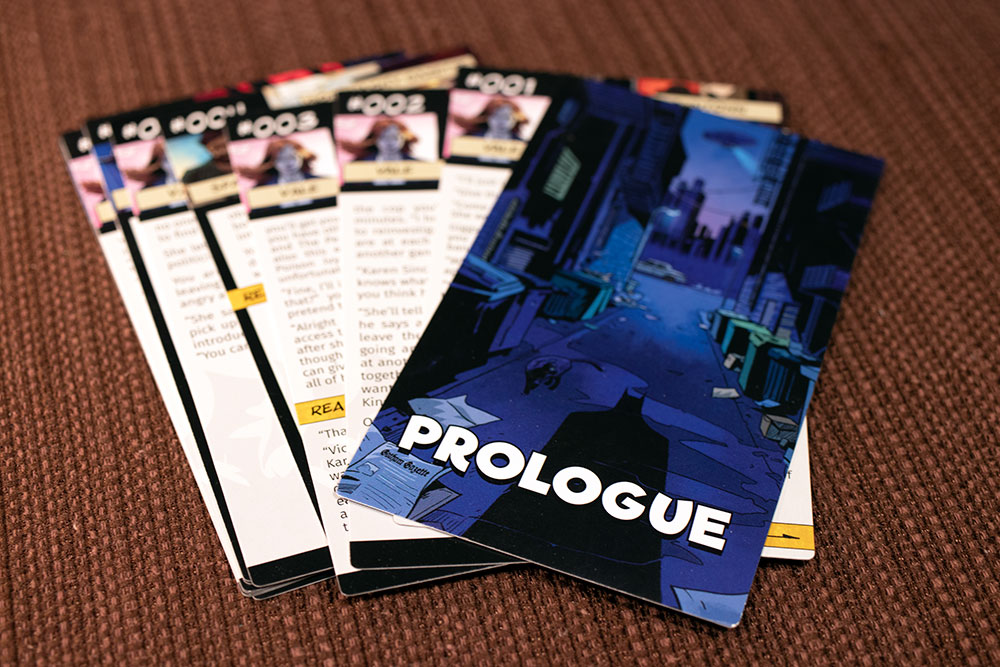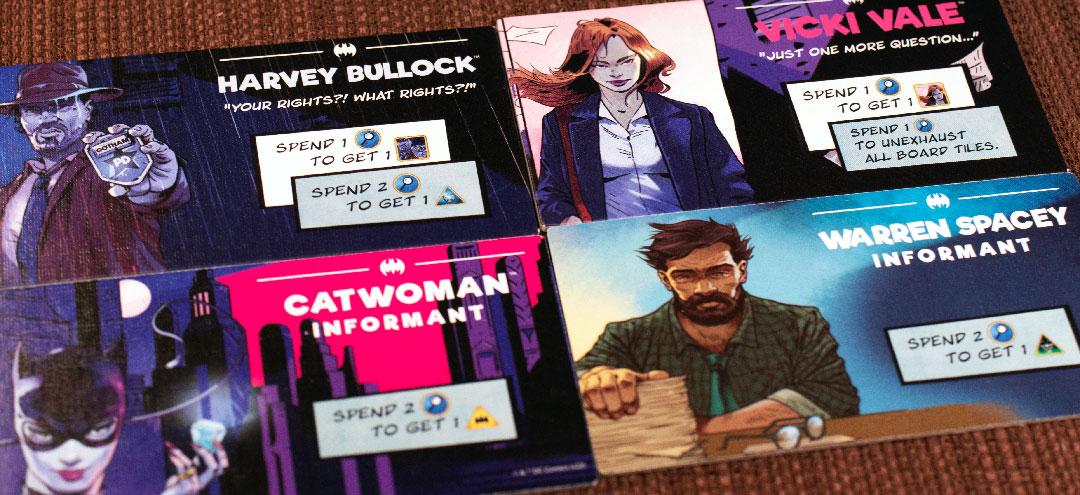 When it comes to comic book superheroes, Batman has always been right near the top of my favorites. I grew up reading Batman, Detective Comics, and watching the 90s Animated Series. So when Portal Games announced that they would be releasing a Batman-themed version of their award-winning Detective line of games I was excited to give it a try. I always gravitated towards the more detective-oriented Batman stories, I mean, he’s known as the “World’s Greatest Detective” for a reason. So, this pairing seems like a match made in heaven. Is Batman Everybody Lies the game fans have been looking for? Let’s find out.
When it comes to comic book superheroes, Batman has always been right near the top of my favorites. I grew up reading Batman, Detective Comics, and watching the 90s Animated Series. So when Portal Games announced that they would be releasing a Batman-themed version of their award-winning Detective line of games I was excited to give it a try. I always gravitated towards the more detective-oriented Batman stories, I mean, he’s known as the “World’s Greatest Detective” for a reason. So, this pairing seems like a match made in heaven. Is Batman Everybody Lies the game fans have been looking for? Let’s find out.
Gameplay Overview:
Batman: Everybody Lies is, in fact, not a social deduction game, but a mystery-solving game set in Gotham City. Surprisingly, the players don’t take on the role of the titular character. While the caped crusader will be making appearances, the players instead control four less iconic characters: Catwoman, Detective Harvey Bullock, and journalists Vicki Vale and Warren Spacey (I’ll admit I had to look up that last one).

Each character has a token converting power and any characters not being controlled by a player are flipped to their informant side. The only difference with the informant version is that they won’t be using character stories. The game comes with 3 main scenarios and a shorter prologue to help you get your feet wet.
If you’ve played any of the Detective line of games, a lot will feel familiar here. You’ll begin the case with an intro and a series of leads. Each lead you follow will cost you a space on the investigation track. The mundane locations (Downtown, City Hall, and the Gotham Gazette) have no extra costs. However, some of the seedier locations (Arkham Asylum, The Underground, Blackgate Penitentiary, and the Batcave) all cost a special type of token to enter (more on that later).
Occasionally, lead cards will prompt you to head to the online database to lookup information. These usually take the form of newspaper clippings, audio transcripts, or case files. New for Everybody Lies are the Personal Goal Deck and Scene deck. The first has characters being controlled by a player extra cards they can draw to further their personal agenda. The latter are comic book-style art panels to help players immerse themselves into the scene.
Players will continue following leads, discussing evidence and theories, and generally trying to solve the case until the investigation token reaches one of the colored spaces. Then they’ll need to head online to make their final report, which will ask you a few multiple-choice questions on the case and grade your answers.

Game Experience:
If you’ll scroll back through some of my previous reviews on the Detective series, for the most part I’ve been all-in on it. Other than a few missteps (Dig Deeper), I enjoy the games and like what they do. So where does Everybody Lies fall in with that line up? I think it does a lot of things right but has a few missteps as well.

First off, I think that the theme was a natural fit for this game system. Originally, I was a little bummed that you don’t get to control Batman. I mean, he’s the most exciting character in Gotham. But after playing the game, I definitely understood more of the design choice. In these cases, you are not just interacting with Batman’s rogue’s gallery. Sure, you’ll have your fair share of encounters with super villains, but more than that you’ll be talking to street-level people. A councilwoman, a lawyer, low-level gang members, history professors, and others are the main interaction point of the game. The thought of Batman spending chatting up a real estate agent in the middle of the day is probably a bit of a stretch, so I get the design choices here. That being said, I’m not sure how many players are excited about controlling Warren Spacey.

Speaking of the characters, I thought that the story cards were a great addition. It helps to give players a little bit more excitement about who their characters are and their motivations. Each case opens with a potentially secret motivation for your character and throughout the case, certain leads will let you draw story cards to give you further details, usually within the realm of your motivation. I was a big fan of that system and the depth that it added to the game. I will say that we played pretty much open hand, as most of the motivations were fairly in line with what we were doing anyway, so don’t expect any “sabotage” style elements here.
However, the one thing I didn’t like with the characters was the new token system. To visit certain places in the Gotham City underworld you had to cash in a specific token. Like if we wanted to follow up on a lead in Arkham Asylum, we had to spend one “Batman” token. How do you get those? Catwoman (either character or informant) can spend two activation tokens to get one. There are three of these special types of tokens, and each has a corresponding character that can gain one by spending two investigation tokens. Frankly, this felt like pointless busywork to make the token system feel more complex than it is. Eventually, we just stopped exchanging them and just used two investigation tokens when we wanted to go to one of those locations. But it’s definitely a good thing the story deck was here, or else the characters would have all felt pretty much the same.

The other new addition to the game was the scene deck. While it doesn’t have a massive impact on the gameplay, it does help to immerse you into the story more. At certain points, a lead card will tell you to draw a scene card that will show what the lead card is describing in a few comic book panels. While fans of the comic will probably enjoy the art, I do wish they had a bit more gameplay impact. I almost expected to find hidden clues on all of them. Although I think I did find a teaser here and there in the cards.
Finally, let’s talk about the online database integration. While it worked, and they even did some nice thematic touches (having the newspaper spin-in and needing to use a magnifier to read it), I didn’t feel like it was utilized to its fullest. Almost everything we looked up were just newspaper clippings, transcripts, or even just a character portrait. I feel like that 90%+ of what we found there could have easily been handouts or cards in a deck. It was very rare for a case to use other multimedia elements or other kinds of interactions that could take advantage of an online database. Which is too bad as that’s when Detective can be the most fun, when you are getting something that cardboard and paper just can’t provide.
Final Thoughts:
While not perfect, Batman: Everybody Lies is a solid entry into the genre that hopefully can improve upon things with future expansions. I think Batman fans will still enjoy the game despite the causal bumps in the road with it. The story does embrace its theme really well, so Batfans definitely have that to look forward to. Also, I did want to mention that while the box says 2 player minimum, I don’t see any reason this can’t be played solo. Unless you REALLY want hidden motivations, then there would be zero issues playing by yourself.
As far as the detective lineup goes, it’s not as good as say, Season One or even the original Detective, but it is still worth a play for fans of the comic book. I think Everybody Lies does have a positive future ahead of it though, and I’m cautiously optimistic about where they take this series.
Final Score: 3.5 Stars – The theme is a natural fit for the system; however, it’s held back by some questionable mechanics.
 Hits:
Hits:
• Great use of the Batman theme
• New story deck with personal motivations are a welcome addition
• Scene deck has a lot of potential
Misses:
• Online database not used very well
• Token system feels kind of pointless
• No reason it can’t be played solo






















